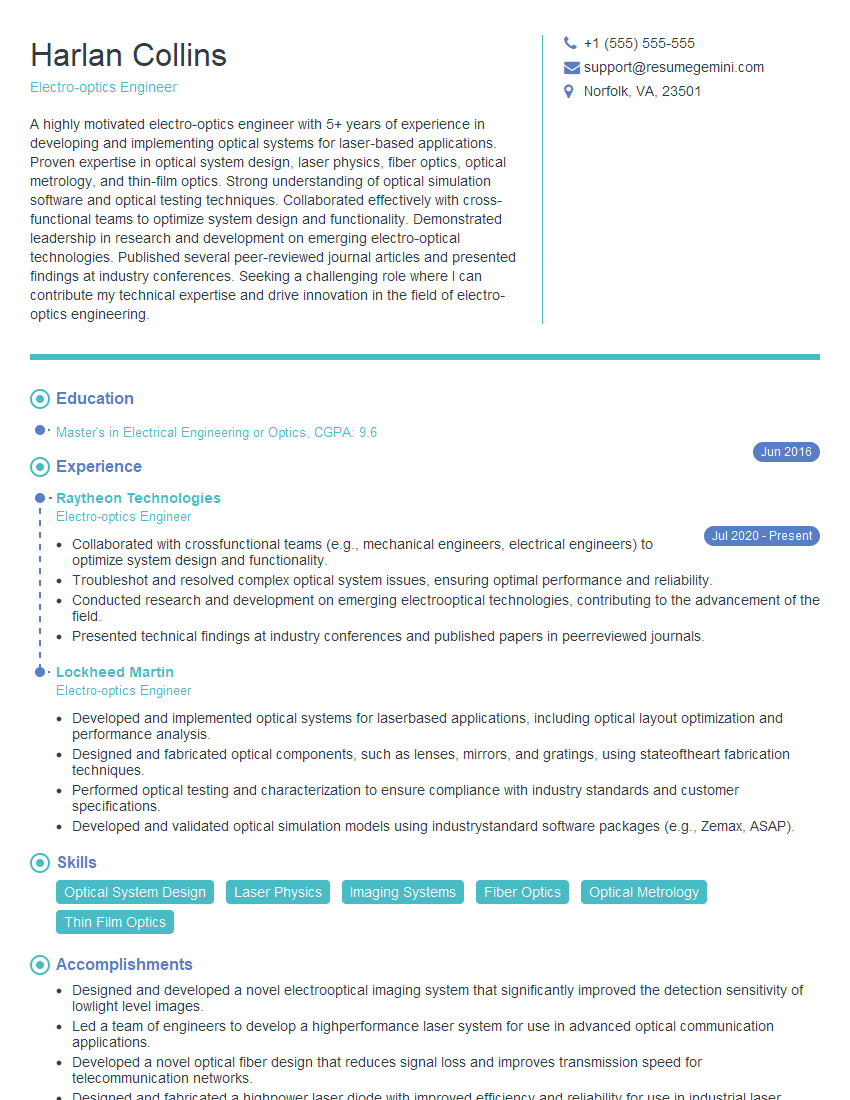Are you ready to stand out in your next interview? Understanding and preparing for Color Rendering Index (CRI) interview questions is a game-changer. In this blog, we’ve compiled key questions and expert advice to help you showcase your skills with confidence and precision. Let’s get started on your journey to acing the interview.
Questions Asked in Color Rendering Index (CRI) Interview
Q 1. Define Color Rendering Index (CRI).
The Color Rendering Index (CRI) is a quantitative measure of how accurately a light source renders the colors of various objects compared to a reference light source, typically daylight.
Imagine you’re painting a portrait. A light source with a high CRI will allow the colors in your paints – the reds, blues, and greens – to appear very close to their true, natural hues. A low CRI light source, however, might distort these colors, making the portrait look less vibrant and realistic. CRI essentially quantifies this accuracy of color representation.
Q 2. Explain the scale of CRI values (0-100).
CRI is rated on a scale of 0 to 100. A CRI of 100 indicates perfect color rendering – the light source renders colors identically to the reference source. As the CRI value decreases, the color rendering accuracy diminishes. For example, a CRI of 80 suggests reasonably good color rendering, while a CRI below 70 indicates noticeably poor color rendering, making colors appear muted or distorted.
Think of it like a test score: 100 is a perfect score, and lower scores indicate increasing deviation from perfection. A CRI of 50 means colors will look significantly different under that light source than they would in natural daylight.
Q 3. What are the limitations of CRI?
While CRI is a valuable metric, it has limitations. Firstly, CRI is based on a limited set of eight test colors, which might not fully represent the vast range of colors encountered in everyday life. This means that a light source might have a high CRI but still render certain colors inaccurately.
Secondly, CRI doesn’t account for the spectral power distribution (SPD) of the light source beyond the eight test colors. Two light sources might have the same CRI but exhibit drastically different spectral distributions, leading to variations in how certain colors appear. Finally, CRI doesn’t assess the color quality of the light itself, only its ability to render colors accurately, ignoring factors like color saturation.
For instance, a light source might render the eight test colors perfectly (CRI 100), but dramatically distort less common hues like certain shades of green or purple, making it unsuitable for applications where those colors are critical.
Q 4. How does CRI differ from color temperature?
CRI and color temperature are distinct but related concepts. Color temperature describes the perceived warmth or coolness of a light source and is measured in Kelvin (K). A lower Kelvin value indicates warmer light (e.g., candlelight), while a higher value signifies cooler light (e.g., daylight). CRI, on the other hand, measures how accurately a light source renders the colors of objects, regardless of its warmth or coolness.
A light source can have a high color temperature (cool light) and a high CRI, or a low color temperature (warm light) and a high CRI. They are independent qualities. Think of it like this: color temperature is the overall tone of the light (warm or cool), while CRI is how well that light reveals the true colors of objects within that tone.
Q 5. Describe the process of measuring CRI.
Measuring CRI involves specialized equipment and a standardized process. A spectrophotometer is used to measure the spectral power distribution (SPD) of the light source being tested. This SPD data is then compared to the SPD of a reference light source (typically daylight) using a specific formula that considers the eight standard test colors. The formula calculates the differences in color appearance and translates these differences into a CRI value.
This process is highly technical and typically performed in calibrated laboratory settings to ensure accuracy and repeatability. The details are too complex to cover fully here, but it involves precise calculations to quantitatively assess the color rendering capabilities of a given light source.
Q 6. What are the key factors influencing CRI values?
Several factors influence CRI values. The phosphor composition in LEDs is a major factor, as different phosphors emit light with varying spectral distributions, impacting color rendering. The operating temperature of the LED also plays a role; changes in temperature can affect the spectral distribution and thus the CRI. Additionally, the design of the light fixture itself, including the reflector and diffuser, can influence how light is mixed and distributed, affecting the final CRI value.
For example, a poorly designed LED fixture might cause uneven light mixing, leading to a lower CRI than the LEDs themselves would produce if used in a better-designed fixture. The choice of the reference illuminant (daylight, incandescent etc.) also subtly affects the measured CRI value.
Q 7. How does CRI relate to the perceived quality of light?
CRI directly impacts the perceived quality of light. A high CRI light source (above 80) produces more vibrant and natural-looking colors, making environments appear more appealing and comfortable. This is crucial in applications where accurate color perception is vital, such as museums, art galleries, retail spaces, and medical settings.
Conversely, a low CRI light source can make colors appear dull, washed-out, or unnatural, affecting the overall mood and ambiance of a space. Imagine viewing a painting under a light source with a low CRI – the colors might appear muted and lifeless, diminishing the artwork’s impact. High CRI lighting makes colors ‘pop’, creating a more aesthetically pleasing and accurate visual experience.
Q 8. Explain the difference between general color rendering and special color rendering.
The Color Rendering Index (CRI) measures how accurately a light source renders the colors of objects compared to a reference source (typically incandescent light). While the overall CRI gives a single number, the distinction between general and special color rendering lies in which colors are being accurately represented.
General color rendering, represented by the overall CRI value (Ra), assesses the accuracy across a range of eight test colors (red, yellow, green, blue, etc.). A higher Ra indicates better overall color rendering. Think of it like a general exam – it covers a broad spectrum of knowledge.
Special color rendering focuses on the accuracy of specific colors critical in certain applications. For example, a light source might have a high Ra but poorly render skin tones or specific shades crucial for a food display. This necessitates evaluation beyond just the Ra value.
The difference is crucial because while a high Ra suggests good color rendering overall, it doesn’t guarantee perfect rendition of all colors. Specific applications may require exceptional accuracy in particular color ranges, highlighting the need to analyze special color rendering parameters alongside Ra. Imagine a painter – they need a good overall palette (high Ra) but might also need specific pigments (special color rendering) for perfect color match.
Q 9. What are some common applications where high CRI is crucial?
High CRI is essential where accurate color perception is paramount. This includes:
- Museums and art galleries: To accurately display artwork and preserve its original colors.
- Healthcare settings: For accurate diagnosis and treatment, especially in dermatology or surgery, where color distinction is critical.
- Jewelry and textile industries: To ensure accurate representation of materials and their shades.
- Food retail: To enhance product appeal by making food appear fresh and vibrant. Think of fresh produce displays in supermarkets.
- Broadcast studios and photography: Accurate color reproduction is crucial for media and image quality.
- Graphic design and print production: To match designs in the digital space to the final print output.
In all these cases, the goal is to minimize color distortion to achieve the most accurate representation possible.
Q 10. What are some applications where a lower CRI might be acceptable?
Lower CRIs might be acceptable in applications where precise color rendition is less critical. Examples include:
- Security lighting: The primary function is illumination, not the exact color rendering of objects.
- Street lighting: While pleasant color is desirable, safety and visibility are priorities, thus reducing the need for ultra-high CRI.
- Industrial lighting: In factories or warehouses, the focus is on efficient task lighting, and color rendering takes a backseat.
- Some residential settings: Ambient lighting may prioritize energy efficiency over extremely precise color rendition.
It’s important to note that ‘acceptable’ depends on the application. A CRI of 70 might be acceptable for a warehouse, but unacceptable for a museum.
Q 11. Discuss the relationship between CRI and energy efficiency.
The relationship between CRI and energy efficiency is complex and not always directly proportional. Historically, high CRI lighting solutions were less energy-efficient compared to those with lower CRIs. Incandescent bulbs, for instance, had excellent CRI but low energy efficiency.
However, advancements in LED technology have changed this. Modern LEDs offer a wide range of CRIs, with high-CRI LEDs becoming increasingly efficient. It’s now possible to achieve both high CRI and high energy efficiency, though the balance sometimes requires trade-offs. Sometimes, slight compromises on CRI might be accepted to achieve higher energy efficiency in certain contexts.
Therefore, the best choice depends on balancing the needs of the application – prioritizing either accurate color reproduction or energy saving, or finding an optimal balance between both.
Q 12. How do different light sources (e.g., incandescent, LED, fluorescent) compare in terms of CRI?
Different light sources exhibit varying CRI values:
- Incandescent bulbs: Traditionally offered excellent CRI (around 98-100), due to their continuous spectrum. However, they are energy-inefficient.
- Fluorescent lamps: CRIs vary significantly, ranging from 60 to 90 or more, depending on the type. They are more efficient than incandescents, but their color rendering is often less accurate.
- LEDs: CRIs have a wide range, from relatively low (below 70) to very high (above 95), offering versatility. The CRI of an LED greatly depends on its phosphor composition and design.
The improved technology and efficiency of modern LEDs have made them a preferred choice in many applications, offering a flexible balance between CRI and energy efficiency. It is important to look at the CRI specification when choosing an LED lamp for a specific application.
Q 13. Explain the importance of CRI in museum lighting.
In museum lighting, CRI is of utmost importance. The goal is to accurately preserve and display artworks by illuminating them with light that renders their colors as naturally and faithfully as possible. High CRI lighting, ideally above 90, minimizes color distortion, preventing colors from appearing dull or unnatural.
Incorrect color rendering can lead to misinterpretations of the artist’s intent, fading of artwork over time, and an overall unsatisfactory viewing experience for visitors. Museums often use specialized lighting systems with very high CRIs and carefully controlled color temperatures to ensure optimal artwork preservation and presentation.
Choosing the right lighting system for a museum involves not only the CRI but also the light intensity, spectral power distribution, and UV and IR filtering to ensure long-term preservation of the art pieces.
Q 14. How does CRI impact color perception in retail environments?
CRI significantly impacts color perception in retail environments. High CRI lighting makes products appear more vibrant, attractive, and true to their actual colors, which enhances their appeal to customers. For example, clothing will appear more realistically, with its textures and colors well represented.
Imagine a high-end clothing store. Poor CRI lighting can make clothes appear dull or washed out, impacting their perceived quality and value. Conversely, high CRI lighting allows customers to accurately assess the quality and feel of the products, encouraging higher sales. This is particularly important in industries selling food, cosmetics, and clothing.
Retailers often use lighting design as a powerful marketing tool. High CRI lighting, combined with strategic color temperature selection, enhances the ambiance of the store and the visual appeal of its merchandise, positively influencing purchasing decisions.
Q 15. Discuss the use of CRI in architectural lighting design.
In architectural lighting design, the Color Rendering Index (CRI) is crucial for ensuring that the colors of objects within a space appear as natural and accurate as possible under the artificial light. A high CRI ensures that the perceived colors are faithful representations of how they appear under natural daylight. This is paramount for spaces where color accuracy is critical, like art galleries, museums, retail stores showcasing clothing, or even residential spaces where people want their home to feel inviting and accurately reflect their decor choices. Imagine a clothing store with poor lighting; the colors of the clothes might look dull or even different than what they are, leading to customer dissatisfaction. A high CRI, however, prevents this, allowing customers to experience the true colors of the products.
Architects use CRI values to select appropriate light sources. For instance, a museum showcasing Renaissance paintings would require lighting with a very high CRI (ideally above 90) to accurately render the rich pigments and subtle nuances of the artwork. Conversely, a factory space might prioritize efficiency and longevity over extremely high color accuracy, allowing for a slightly lower CRI value.
Career Expert Tips:
- Ace those interviews! Prepare effectively by reviewing the Top 50 Most Common Interview Questions on ResumeGemini.
- Navigate your job search with confidence! Explore a wide range of Career Tips on ResumeGemini. Learn about common challenges and recommendations to overcome them.
- Craft the perfect resume! Master the Art of Resume Writing with ResumeGemini’s guide. Showcase your unique qualifications and achievements effectively.
- Don’t miss out on holiday savings! Build your dream resume with ResumeGemini’s ATS optimized templates.
Q 16. How does CRI affect the appearance of skin tones?
CRI significantly impacts the appearance of skin tones. Lower CRI values can lead to unnatural and distorted skin tones, making them appear washed out, overly yellowish, or even sickly. This is because CRI measures how well a light source renders eight specific colors, and skin tones are complex mixtures of these and other colors. A high CRI light source, on the other hand, renders these colors more accurately, resulting in natural and lifelike skin tones. This is especially important in spaces like makeup studios, photography studios, or even bathrooms where accurate color reproduction is crucial for achieving desired aesthetic results.
Imagine applying makeup under a light with a low CRI. The colors might look fine under that light, but stepping into natural daylight might reveal a significant difference – a disastrous outcome for a professional makeup artist! High CRI lighting ensures a consistent and accurate color rendering, regardless of the surrounding environment.
Q 17. How can CRI be improved in lighting systems?
Improving the CRI of a lighting system involves selecting light sources with higher CRI values. This primarily means opting for light sources with a broader spectral distribution, closely mimicking the spectrum of sunlight. Several strategies exist:
- Choosing LED lights with high CRI ratings: Many modern LEDs offer CRIs above 90. The manufacturers will specify the CRI value of their products.
- Using multiple light sources: Combining light sources with different spectral distributions can improve the overall CRI of the system. This is often used in professional settings where a perfect match of a single light source might be expensive or technically impossible.
- Employing color mixing techniques: Sophisticated lighting controls can blend different color temperatures (CCT) to achieve a higher CRI and a more desirable color rendering quality.
- Utilizing phosphor technology in LEDs: LED manufacturers employ different phosphors to broaden the emitted spectrum, resulting in a higher CRI. This is a constant field of research and development, with new technologies emerging consistently.
Careful consideration of these approaches ensures that the lighting system effectively meets the required color rendering demands for a particular application. It’s always advisable to check the manufacturer’s specifications and even conduct tests with samples to ensure the CRI meets your needs.
Q 18. What are some alternative metrics to CRI?
While CRI is widely used, some alternative metrics exist to assess the quality of light and its effect on color rendering. These include:
- TM-30-15: This newer metric provides a more detailed assessment of color fidelity, considering color gamut, color saturation, and individual color rendering. It’s often favored over CRI because it considers more aspects of color perception, addressing some of CRI’s shortcomings.
- CQS (Color Quality Scale): This metric focuses on the overall impression of color quality, offering a single figure that’s sometimes easier to understand than the complex data provided by TM-30-15.
These alternative metrics offer a more comprehensive understanding of how a light source will affect the appearance of colors compared to CRI, addressing some of its limitations with particular color ranges. However, CRI still remains widely utilized and serves as a useful basic benchmark.
Q 19. Explain the concept of color fidelity.
Color fidelity refers to the accuracy with which a light source renders the colors of an object compared to how those colors appear under a reference illuminant, usually daylight. It’s essentially a measure of how accurately colors are reproduced under a given light source. High color fidelity implies that the colors appear very similar under both the light source and the reference illuminant. This is crucial in any scenario where accurate color reproduction is important, like in printing, art restoration, or medical imaging.
Imagine painting a portrait. You carefully match your paints to the subject under natural daylight. But if you display your finished artwork under an artificial light with poor color fidelity, the colors will appear different and less accurate than your intention.
Q 20. How does CRI influence the choice of light source for a particular application?
The choice of light source is heavily influenced by the required CRI for a particular application. For applications needing high color accuracy, such as museums or art galleries, light sources with a CRI of 90 or higher are essential. This ensures the colors of the artwork are faithfully reproduced. In contrast, applications where color accuracy is less critical, such as in industrial settings or parking garages, can use light sources with lower CRI values, prioritizing efficiency and cost-effectiveness over perfect color rendering. This balance between cost, efficacy, and color accuracy is crucial in informed decision making.
For example, a high-end jewelry store would choose LED lighting with a very high CRI to showcase the vibrancy of the gems and precious metals, while a warehouse setting might prioritize energy efficiency, opting for a lower CRI lighting solution.
Q 21. Describe a situation where you had to make a decision based on CRI values.
I recently worked on a project designing the lighting for a high-end chocolate shop. The client was very concerned about accurately showcasing the rich, deep colors of their artisanal chocolates. Initially, they had chosen a cost-effective lighting solution with a CRI of around 70. However, during the lighting simulations and test installations, the colors of the chocolates appeared dull and less appealing than under daylight. I presented the client with data showing the impact of different CRI values on the chocolate’s appearance. Based on this, we opted for LED lighting with a CRI of 95, dramatically improving the visual appeal of the products and ultimately enhancing the customer experience.
This experience reinforced the importance of selecting lighting solutions with appropriate CRI values, particularly in applications where color accuracy directly impacts the customer perception of the product or space.
Q 22. What are the potential consequences of using a light source with low CRI?
Using a light source with a low Color Rendering Index (CRI) can lead to several undesirable consequences. Essentially, a low CRI means that colors under that light source will appear dull, washed out, or even different from how they appear under natural daylight or a high-CRI light. This has a significant impact in various applications.
- In commercial settings, such as retail stores or art galleries, low CRI lighting can negatively affect the display of products or artwork, leading to reduced customer appeal and potentially impacting sales.
- In industrial settings, accurate color perception is critical for tasks like quality control and inspection. Low CRI lighting can introduce errors in these processes.
- In healthcare, accurate color rendering is vital for diagnostics, particularly in dermatology and surgery. A low CRI light source can misrepresent skin tones or tissue coloration.
- In residential settings, while less critical than in professional contexts, low CRI lighting can still create an unpleasant and unnatural atmosphere, making spaces feel less inviting.
For instance, imagine trying to choose paint colors in a room lit by a low CRI bulb – the colors on the paint swatches might look significantly different from the final wall color after painting. This is because the light source is not accurately representing the true color of the paint.
Q 23. How does the color spectrum of the light source influence CRI?
The color spectrum of a light source is directly tied to its CRI. CRI is calculated by comparing the rendered colors of eight test color samples under the light source to their appearance under a reference light source (usually daylight). The closer the rendered colors are to the reference, the higher the CRI.
A light source with a broad, continuous spectrum that closely resembles daylight will generally have a higher CRI. This is because a full spectrum light source provides a wider range of wavelengths needed to accurately render various colors. Conversely, light sources with narrow, spiky spectra, such as some older fluorescent lamps, might have poor color rendering in certain color ranges, leading to a lower CRI.
For example, a light source lacking in red wavelengths might make red objects appear dull or brown. Similarly, a deficiency in blue wavelengths could affect the accurate portrayal of blues and greens. The CRI score reflects the overall accuracy of color rendering across the spectrum.
Q 24. Explain the impact of CRI on human visual perception.
CRI significantly impacts human visual perception. Our brains are highly adept at interpreting color, and accurate color rendition is crucial for many aspects of our daily lives. A high CRI light source provides a more natural and comfortable viewing experience, leading to reduced eye strain and a more pleasant environment.
- Color perception accuracy: High CRI lights ensure colors are rendered accurately, allowing for a true representation of objects and scenes. This is crucial for tasks requiring precise color differentiation, such as design or art appreciation.
- Visual comfort: Lights with a high CRI produce a more natural and comfortable light, reducing eye strain and improving visual acuity.
- Mood and atmosphere: The accurate representation of colors under high-CRI lighting can influence mood and atmosphere. A vibrant, accurately colored environment tends to feel more inviting and pleasant.
- Health and wellbeing: Some studies suggest that a lack of accurate color rendition can have subtle negative effects on mood and wellbeing. Though research continues, maintaining proper color rendering is generally viewed as advantageous for health.
Imagine trying to read a book under a light that washes out the colors in the illustrations—it makes reading less enjoyable and potentially more difficult. High CRI lighting addresses this by providing an accurate and pleasing representation of the colors on the page.
Q 25. Compare and contrast CRI with other color rendering metrics.
While CRI is a widely used metric, other color rendering metrics exist, each with its own strengths and weaknesses. The most prominent alternative is the Color Quality Scale (CQS). Both aim to quantify the quality of light’s color rendering but differ in their methodology.
- CRI: Focuses on the color rendering of eight specific color samples and provides a single index value (Ra) ranging from 0 to 100. It’s widely adopted, but criticized for not fully capturing the nuances of color rendering beyond the eight test samples.
- CQS: Uses a more comprehensive set of color samples (often more than 100) and considers the entire visible spectrum. This provides a more complete representation of color rendering characteristics but is less widely adopted than CRI.
Think of it like comparing a doctor’s overall health assessment (CRI) to a detailed blood panel (CQS). CRI offers a quick summary, while CQS provides a much more comprehensive picture. Both are useful, but their applications may vary depending on the need for detail.
Q 26. Describe the challenges in accurately measuring and specifying CRI.
Accurately measuring and specifying CRI presents several challenges:
- Standardization: Although standardized methods exist, variations in equipment and procedures can lead to inconsistencies in CRI measurements between different labs or testing environments.
- Reference illuminant: The choice of reference illuminant (e.g., daylight) can affect the resulting CRI value. Different reference illuminants may be more appropriate for specific applications.
- Test samples: The selection of test samples influences the CRI value. Using different sets of samples can lead to different results.
- Metamerism: Two objects may appear to have the same color under one light source but different colors under another. This phenomenon, known as metamerism, complicates accurate color rendering assessment.
- Observer variability: Human perception of color can also vary, influencing the subjective evaluation of color rendering quality.
These challenges underscore the need for careful calibration of equipment, standardized procedures, and a clear understanding of the limitations of CRI as a metric.
Q 27. How do advancements in LED technology affect CRI values?
Advancements in LED technology have significantly improved CRI values. Early LEDs often exhibited poor color rendering, but improvements in materials science and manufacturing techniques have led to LEDs with CRI values approaching and even exceeding 90. This has been achieved through:
- Improved phosphor technology: The phosphors used to convert blue light from the LED chip into other wavelengths have become more efficient and generate a broader spectrum of light, improving color rendition.
- Multi-chip LEDs: Combining multiple LED chips of different colors allows for a more complete spectrum, thereby improving CRI.
- White-light mixing techniques: Advanced techniques for mixing different wavelengths of light create a more natural-looking white light with higher CRI.
As a result, high-CRI LEDs are now increasingly used in various applications, offering both energy efficiency and superior color rendering.
Q 28. Discuss the future trends and developments related to CRI.
Future trends and developments in CRI research and application include:
- Beyond Ra: The development of more comprehensive color rendering metrics that go beyond the single Ra value of CRI, providing a more nuanced understanding of color rendering characteristics across the entire spectrum.
- Improved measurement techniques: The development of more accurate and standardized methods for measuring color rendering will reduce discrepancies between different measurement systems.
- Personalized lighting: Advancements in LED technology could lead to personalized lighting solutions that adapt to individual preferences and visual needs, optimizing color rendering based on individual sensitivities.
- Integration with other lighting parameters: The integration of CRI with other lighting parameters, such as light distribution and energy efficiency, will lead to more holistic lighting design solutions.
- Focus on specific applications: Research will likely focus on optimizing color rendering for specific applications, such as healthcare, retail, or art galleries, where the demands for accurate color rendition are particularly high.
The goal is to move towards a more holistic understanding of color rendering, ensuring that lighting solutions optimize not only energy efficiency but also provide a visually comfortable and accurate experience for users.
Key Topics to Learn for Color Rendering Index (CRI) Interview
- Definition and Significance of CRI: Understand the fundamental concept of CRI, its scale (0-100), and why it’s crucial in various lighting applications.
- CRI Measurement and Calculation: Familiarize yourself with the methods used to measure and calculate CRI, including the role of test color samples and spectral power distributions.
- Impact of Different Light Sources: Analyze how various light sources (incandescent, fluorescent, LED) affect CRI values and the resulting color rendering.
- CRI and Human Perception: Explore the relationship between CRI values and human perception of color accuracy and visual comfort. Understand the limitations of CRI as a sole metric for color quality.
- Applications of CRI in Diverse Fields: Discuss the practical applications of CRI in areas like architectural lighting, museum lighting, photography, and retail displays, highlighting specific challenges and solutions in each.
- CRI vs. Other Color Rendering Metrics: Compare and contrast CRI with other color rendering metrics (e.g., TM-30-18, Ra) and understand their respective strengths and weaknesses.
- Troubleshooting and Problem Solving: Be prepared to discuss scenarios where poor color rendering is observed and how CRI analysis can help identify and resolve the issue. This could involve analyzing spectral data or suggesting alternative light sources.
- Advanced CRI Concepts (if applicable): Depending on the seniority of the role, prepare to discuss more advanced topics such as the limitations of CRI, the development of new color rendering metrics, or the impact of CRI on specific color spaces.
Next Steps
Mastering Color Rendering Index (CRI) is essential for career advancement in lighting design, engineering, and related fields. A strong understanding of CRI demonstrates technical expertise and problem-solving abilities highly valued by employers. To maximize your job prospects, create an ATS-friendly resume that highlights your skills and experience effectively. ResumeGemini is a trusted resource to help you build a professional and impactful resume. Examples of resumes tailored to Color Rendering Index (CRI) expertise are available to guide you in showcasing your qualifications. Take the next step towards your dream career – build a compelling resume that reflects your knowledge of CRI!
Explore more articles
Users Rating of Our Blogs
Share Your Experience
We value your feedback! Please rate our content and share your thoughts (optional).
What Readers Say About Our Blog
This was kind of a unique content I found around the specialized skills. Very helpful questions and good detailed answers.
Very Helpful blog, thank you Interviewgemini team.





